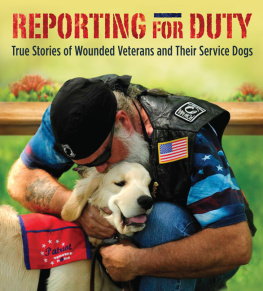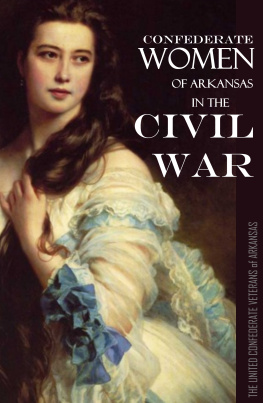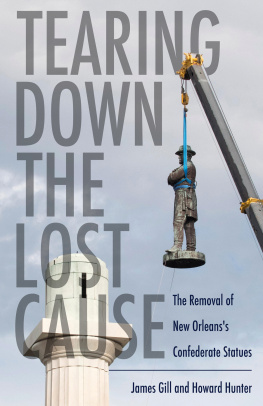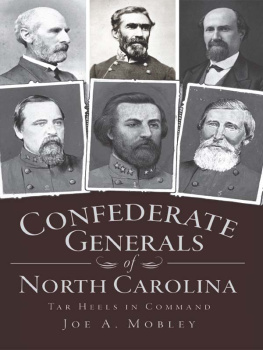Confederate Veterans in Northern California
Confederate Veterans in Northern California
101 Biographies
Jeff Erzin

McFarland & Company, Inc., Publishers
Je f ferson, North Carolina
ISBN (print) 978-1-4766-8103-0
ISBN (ebook) 978-1-4766-3956-7
Library of Congress and British Library
cataloguing data are available
Library of Congress Control Number 2020020596
2020 Jeff Erzin. All rights reserved
No part of this book may be reproduced or transmitted in any form or by any means, electronic or mechanical, including photocopying or recording, or by any information storage and retrieval system,without permission in writing from the publisher.
Front cover: top to bottom Edward Derrell Beard (photograph courtesy of Nancy Wilson), Edwin Augustus Garrison (courtesy of David M. Pierce), Lieutenant Colonel John Gotea Pressley (courtesy of Bruce Tognazzini), James Fowler Pressley (courtesy of Bruce Tognazzini)
Printed in the United States of America
McFarland & Company, Inc., Publishers
Box 611, Jefferson, North Carolina 28640
www.mcfarlandpub.com
For my wife, Tracy
Table of Contents
Preface
The Civil War destroyed lives, families, fortunes and the desire to stay within the war-torn areas of the East Coast and its western fringes. With the onset of Reconstruction, the South continued to be at war with the government and to deal with unsavory elements of the northern population who headed south to take advantage of that now weakened section of the country. California offered new hope for these families, not only to start a new life far from the horrors but also to build families that would become prominent members of California society.
I was fascinated by the Civil War from an early age, growing up in Pennsylvania and spending many summers in Gettysburg. Many years later, living in the San Francisco Bay Area, I came across a story involving exConfederate soldiers who were buried in Santa Rosa in Sonoma County. This intrigued me, for I wondered just how many Southerners had moved to northern California after the war. After taking the Gettysburg Battlefield Guide test in 2012 just for fun and to test my knowledge of the battle, I started work on collecting information on these exConfederate Californians at the National Archives center just south of San Francisco. I decided to write about their lives in the war, since my expertise was in the military aspect of the War Between the States. I then proceeded to locate these individuals in their regiments using the National Archives, which houses all the muster sheets from American servicemen (only deceased), starting with the American Revolution and going through the present day. As I worked deeper and deeper into the lives of these men, I realized that some of the biographies written many years later were embellished with deeds that really didnt occur. Great-grandfather supposedly fought heroically in many a battle, but I would discover he had deserted two months after enlisting. On the other hand, many of these men led very quiet lives in California after the war but had seen much bloodshed in their four years of service, witnessing many very famous and historic events.
The most difficult part of writing this book was keeping the stories manageable, since I had come across over six hundred individuals. I decided to make a line from Fresno to Monterey my division between northern and southern California. I have been told that it is a stretch calling that area northern California, since it is known as Central California. Those areas, especially Fresno County, included a large proportion of Confederate veterans, hence I consider it the cutoff point. The book covers a cross section of the over six hundred veterans I have researched. I am very grateful to all the individuals who have generously allowed me to use their ancestors photographs in the book. Special thanks go to Sal Manna, Calaveras County historian and author, and John Morton, Colusa County historical researcher, for supplying me with many photographs; Millie Starr and Janet Lancaster of Stanislaus County, both researchers extraordinaire; my mother-in-law, Maureen Fischl, who helped me translate many letters in unintelligible handwriting; and finally my wife Tracy, who helped me with much of the individual research and has not complained about my very early morning wakeups to write on the weekends. In closing, I hope the reader is as excited as I have been to learn the untold stories of these Californians.
Jeff Erzin
Spring 2020
Introduction
After the war, the Confederate veterans returned to a land devastated by battles and bloodshed. Farms had been destroyed, plantations burned and families torn apart by the death of loved ones. The decision to leave a home that may have been in the family for generations must have been very difficult.
Just after the war, some wealthier families booked passage on ships bound for San Francisco, where they settled or moved out to locations known and already settled by members of their community back East. Many of the farmer class joined wagon trains headed west, arriving in the central valley of California, where they settled in groups.
The Alabama Colony, near the present town of Madera, was just such a community. Started in 1868 by families from Alabama, Georgia and Mississippi, they farmed until around 1874, when drought caused them to abandon the community. The settlers in the Central Valley were able to farm different crops from their plantings in the South. Many of the families planted vineyards and orchards or crops such as wheat and alfalfa. Seeing the wide-open areas, many of the veterans decided that raising livestock would benefit them financially. Another colony of Missouri Southerners settled in Yolo County. The wealthier families settled in cities such as Sacramento, Stockton, San Francisco and Oakland. Lawyers, doctors and professionals settled in San Francisco, where they could service the elite of the city. Near Hollister, San Benito County, a small community of Southern families were nicknamed Confederate Corners. In Santa Rosa, Sonoma County, the prestigious families of Pressley and Robert Press Smith settled. Members of the plantation class in South Carolina, the families became pillars of the Santa Rosa community. The Dozier family, also of South Carolina, settled in the area of Rio Vista, Solano County, where they too became prestigious pioneers of the community. The wealthy Vaughn family moved from Missouri with their slaves to Benicia, Solano County. California being a free state, their slaves were freed. The oldest son, Joseph, went back East to fight for the Confederacy and was killed in battle. The family were rich enough to have the body brought back to Benicia. This may be the only Confederate soldier killed in battle to be buried in California. Joes story is profiled in this book. The veterans tried to live quietly and start their lives anew.
But what of their time in the war? Little if anything has been written, and what has been is in memoirs and newspapers or handed down through the family. When the war started, many of these individuals were students or already working in the professions they had chosen. Most felt the war would be short and an adventure they could not pass up. Some felt they needed to protect their homes from the invading North, and others wanted to protect a way of life from financial destruction that would be caused by freeing their slaves. Some would fight for the next four years; some would desert. The following stories follow the battles, the hardships of army life, and for some, their changing view of what war really meant and their new understanding of the immorality of slavery.









